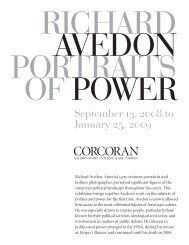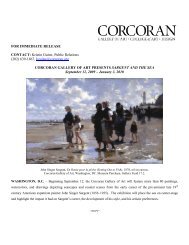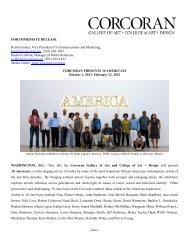Aaron Douglas, Into Bondage, 1936 - Corcoran Gallery of Art
Aaron Douglas, Into Bondage, 1936 - Corcoran Gallery of Art
Aaron Douglas, Into Bondage, 1936 - Corcoran Gallery of Art
Create successful ePaper yourself
Turn your PDF publications into a flip-book with our unique Google optimized e-Paper software.
<strong>Aaron</strong> <strong>Douglas</strong>, <strong>Into</strong> <strong>Bondage</strong>, <strong>1936</strong><br />
corcoran gallery <strong>of</strong> art
<strong>Aaron</strong> <strong>Douglas</strong> (born Topeka, KS, 1899–died Nashville, TN, 1979)<br />
<strong>Into</strong> <strong>Bondage</strong>, <strong>1936</strong><br />
Oil on canvas, 60 3/8 x 60 1/2 in. (153.4 x 153.7 cm)<br />
Signed lower right: AARON DOUGLAS<br />
Museum Purchase and partial gift from Thurlow Evans Tibbs, Jr., The Evans-Tibbs Collection, 1996<br />
About the <strong>Art</strong>ist<br />
<strong>Aaron</strong> <strong>Douglas</strong>, a major figure <strong>of</strong> the Harlem Renaissance, was<br />
one <strong>of</strong> the first African American artists to draw on contemporary<br />
black culture as subject matter for his work. Born in Topeka, Kansas<br />
in 1899, <strong>Douglas</strong> recognized his artistic ambition early. He attended<br />
the University <strong>of</strong> Nebraska where he was the only African American<br />
student pursuing art. After teaching high school art classes in Kansas<br />
City, Missouri, <strong>Douglas</strong> relocated and immersed himself in the New<br />
York City art world. <strong>Douglas</strong>’ first commission was to illustrate<br />
Alain Locke’s 1925 compilation <strong>of</strong> contemporary African American<br />
prose, The New Negro. The success <strong>of</strong> this project and others<br />
established <strong>Douglas</strong> as a leading artist in the rapidly developing<br />
Harlem Renaissance movement. Poet and writer Langston Hughes<br />
encouraged other African American artists to aspire to <strong>Douglas</strong>’<br />
example and to convey their “individual dark-skinned selves<br />
without fear or shame.”<br />
<strong>Douglas</strong> continued to create inspiring images for African<br />
Americans through several series <strong>of</strong> murals depicting black history.<br />
In 1935, <strong>Douglas</strong> formed the Harlem <strong>Art</strong>ists Guild “to band all<br />
the Harlem artists together in a cultural group” and to lobby for<br />
African American artists to gain employment under the federal<br />
Works Progress Administration. <strong>Douglas</strong> left New York in 1937<br />
to establish the art department at Fisk University in Nashville,<br />
Tennessee, where he remained active until 1976. An inspirational<br />
educator, <strong>Douglas</strong> influenced generations <strong>of</strong> African American artists.<br />
About the <strong>Art</strong><br />
<strong>Into</strong> <strong>Bondage</strong> premiered as one element <strong>of</strong> a four-part mural series<br />
in the Hall <strong>of</strong> Negro Life at the <strong>1936</strong> Texas Centennial Exposition<br />
in Dallas. It was <strong>Douglas</strong>’ intention to create and present fresh,<br />
modern images depicting the contributions <strong>of</strong> African Americans<br />
to the state’s history and achievements. This painting portrays<br />
slavery, as <strong>Douglas</strong> believed that understanding the past was<br />
essential to moving forward in the future. Aspiration—the only<br />
other surviving mural from the series, which is in the collection<br />
<strong>of</strong> the Fine <strong>Art</strong>s Museums <strong>of</strong> San Francisco—depicts <strong>Douglas</strong>’<br />
20th century contemporaries as an educated urban class. Many<br />
white fairgoers at the Exposition refused to believe that the highly<br />
accomplished artist who painted these works was African American.<br />
<strong>Into</strong> <strong>Bondage</strong> exemplifies <strong>Douglas</strong>’ unique compositional style<br />
which includes radiating circles, silhouetted forms with few interior<br />
details, and Cubist-influenced overlapping shapes. The reddishorange<br />
color <strong>of</strong> the manacles and star contrasts the analogous<br />
palette <strong>of</strong> misty blues, mauves, and lavenders. The bound captives<br />
descend toward two large ships that are set to transport the Africans<br />
across the Atlantic to their future <strong>of</strong> enslavement. While most <strong>of</strong> the<br />
men’s heads are bowed low in despair, the woman on the left looks<br />
up and raises her shackled hands above the horizon line. The large<br />
central figure’s eye slit recalls the masks <strong>of</strong> the Dan people <strong>of</strong> Africa.<br />
His pr<strong>of</strong>iled head and chest and twist <strong>of</strong> the hips demonstrate<br />
<strong>Douglas</strong>’ predilection for ancient Egyptian art. Although the man<br />
stands on a pedestal referencing the auction block from which he<br />
will be sold, a ray <strong>of</strong> light from the North Star, which guided slaves<br />
on the Underground Railroad, illuminates his face and foreshadows<br />
his ultimate freedom.<br />
Suggested Dialogue<br />
• If you had not studied history and the enslavement <strong>of</strong> Africans,<br />
could you still interpret the narrative <strong>of</strong> this work?<br />
• How do you know the people are to become slaves?<br />
• How is the composition affected by the concentric circles?<br />
• The painting is composed <strong>of</strong> flat planes with visible brushstrokes<br />
and no shading. How does the artist achieve depth?<br />
Extended Dialogue<br />
• What do think the gesture <strong>of</strong> the women on the left signifies?<br />
Does it indicate hope or despair?<br />
• Why do you think <strong>Douglas</strong> chose not to depict this scene<br />
in a naturalistic manner? How does his style alter the meaning<br />
or your impression <strong>of</strong> the work?<br />
• Look at the star and its ray <strong>of</strong> light shining in the middle <strong>of</strong> the<br />
canvas. Why do you think <strong>Douglas</strong> included the star?<br />
How would the mood change if the star was removed?<br />
What other symbols could the artist have included to give<br />
a sense <strong>of</strong> hope to the narrative?<br />
• This painting was originally part <strong>of</strong> a four-painting series. If you<br />
had three more canvases to complete the series, what scenes<br />
from African American history would you choose to convey?<br />
Vocabulary<br />
Harlem Renaissance: The period between<br />
1919 and the early 1930s <strong>of</strong> burgeoning<br />
African American culture, which included<br />
visual art, theater, prose, and poetry, and<br />
was centered in the Harlem neighborhood<br />
<strong>of</strong> New York City. These African American<br />
intellectuals believed that increasing<br />
awareness <strong>of</strong> black culture through various<br />
art forms would reduce racial tensions<br />
and barriers in 20th century America.<br />
Works Progress Administration: A federal<br />
government agency established in 1935<br />
to provide work opportunities to those<br />
suffering in the Depression. The administration<br />
also set up the Federal Writer’s<br />
Project and the Federal <strong>Art</strong>s Project to<br />
make jobs available to unemployed arts<br />
pr<strong>of</strong>essionals.<br />
Cubism: An artistic movement <strong>of</strong> the early<br />
20th century lead by artists Pablo Picasso<br />
and Georges Braque. Cubism abandoned<br />
the traditional fixed viewpoint, and instead<br />
explored a multiplicity <strong>of</strong> viewpoints to<br />
develop an accumulated idea <strong>of</strong> the subject<br />
resembling abstract, geometric forms.<br />
Analogous colors: Two or three colors<br />
which are adjacent to each other on the<br />
color wheel. (i.e. orange, orange-red, red)<br />
Dan: Ethnic goup located in the West<br />
African countries <strong>of</strong> Liberia and Côte<br />
d’Ivoire.<br />
North Star: Runaway slaves on the Underground<br />
Railroad mostly moved at night to<br />
avoid being caught in the daylight. They<br />
used this bright beacon as a navigational<br />
device to find their way north, their intended<br />
direction towards freedom.<br />
Underground Railroad: A network <strong>of</strong> both<br />
black and white people who aided runaway<br />
slaves along their journey to freedom in<br />
the North. Fugitives would find shelter<br />
and food at these homes or establishments<br />
until it was safe to continue traveling and<br />
would then move at night in 10 to 20 mile<br />
increments.<br />
Concentric: Objects or shapes that share<br />
a common center.<br />
Support for <strong>Art</strong>s 101 materials is made possible in part by the Women’s Committee <strong>of</strong> the <strong>Corcoran</strong> and the DC Commission on the <strong>Art</strong>s and Humanities.
endnotes<br />
Jennifer Wingate, “<strong>Aaron</strong> <strong>Douglas</strong>, <strong>Into</strong> <strong>Bondage</strong>” in <strong>Corcoran</strong><br />
<strong>Gallery</strong> <strong>of</strong> <strong>Art</strong>: American Paintings to 1945, ed. Sarah Cash, et al,<br />
(Washington, D.C.: <strong>Corcoran</strong> <strong>Gallery</strong> <strong>of</strong> <strong>Art</strong> in association with<br />
Hudson Hills Press, 2011), 246-247.<br />
Susan Badder, “<strong>Into</strong> <strong>Bondage</strong>” in A Capital Collection: Masterworks<br />
from the <strong>Corcoran</strong> <strong>Gallery</strong> <strong>of</strong> <strong>Art</strong>, ed. Amy Pastan (Lingfield, Surrey:<br />
Third Millennium Publishing Limited, 2002), 200-201.<br />
Susan Badder et al, “<strong>Aaron</strong> <strong>Douglas</strong>” in <strong>Corcoran</strong> <strong>Gallery</strong> <strong>of</strong> <strong>Art</strong><br />
African-American <strong>Art</strong> Educators’ Resource Pack (Washington , D.C.:<br />
<strong>Corcoran</strong> <strong>Gallery</strong> <strong>of</strong> <strong>Art</strong> Education Department, 1999), unpaginated.<br />
Renee Ater, “Creating a ‘Usable Past’ and a ‘Future Perfect Society’”<br />
in <strong>Aaron</strong> <strong>Douglas</strong>: African American Modernist, ed. Susan Earle<br />
(New Haven: Yale University Press, 2007), 95-112.
Alma Thomas, Pansies in Washington, 1969<br />
corcoran gallery <strong>of</strong> art
Alma Thomas (born Columbus, GA, 1891–died Washington, D.C., 1978)<br />
Pansies in Washington, 1969<br />
Acrylic on canvas, 50 x 48 in. (127 x 121.92 cm)<br />
Gift <strong>of</strong> Vincent Melzac, 1972<br />
© Estate <strong>of</strong> Alma Thomas<br />
About the <strong>Art</strong>ist<br />
Alma Thomas, a devoted teacher, gifted artist, and dedicated<br />
political activist, was born in 1891 in Columbus, Georgia. Her family<br />
moved to Washington, D.C. in the early 1900s because the city <strong>of</strong>fered<br />
better educational and employment opportunities for African<br />
Americans. After receiving a teacher’s certificate, Thomas continued<br />
her studies at Howard University, eventually becoming the first<br />
graduate <strong>of</strong> the <strong>Art</strong> Department in 1924. She dedicated herself<br />
to educating the youth <strong>of</strong> D.C., teaching art for 35 years at Shaw<br />
Junior High School.<br />
In 1943 Thomas served as the vice president <strong>of</strong> the Barnett<br />
Aden <strong>Gallery</strong>, the first private gallery in D.C. to exhibit work by artists<br />
<strong>of</strong> all races. Through this association, Thomas came in contact<br />
with a variety <strong>of</strong> modern art styles—from Realism to Abstract<br />
Expressionism. By 1954, Thomas’ paintings had shifted from<br />
a realistic style to an abstract one which emphasized color and<br />
shape. Her new work received critical attention in the mid-1960s,<br />
and in 1972, at the age <strong>of</strong> 80, she had a solo show at the Whitney<br />
Museum <strong>of</strong> American <strong>Art</strong> in New York (she was the first African<br />
American woman to do so) and a retrospective at the <strong>Corcoran</strong><br />
<strong>Gallery</strong> <strong>of</strong> <strong>Art</strong>.<br />
About the <strong>Art</strong><br />
Thomas met many D.C. painters, including those who were part<br />
<strong>of</strong> the Washington Color School. She was affected by these artists<br />
who were primarily interested in “pure, flat color, reduced to simple<br />
forms.” However, Thomas’ work differed from theirs in several<br />
significant ways, including her handling <strong>of</strong> pigment, use <strong>of</strong> primed<br />
canvas, and subject matter. Thomas was strongly influenced by<br />
colors in nature, especially those found in the flowers and greenery<br />
<strong>of</strong> her garden and other areas <strong>of</strong> D.C.<br />
Pansies in Washington is part <strong>of</strong> Thomas’ “Earth Paintings”<br />
series, which was inspired by aerial views <strong>of</strong> D.C.’s areas <strong>of</strong> natural<br />
beauty such as the Arboretum’s flower beds and the Tidal Basin’s<br />
cherry blossoms. To create this work, Thomas first primed the<br />
canvas, then used pen to draw each rectangle onto the canvas,<br />
and finally painted small, irregular blocks <strong>of</strong> red, blue, pink, green,<br />
orange, purple, and yellow in concentric circles to suggest a large<br />
bed <strong>of</strong> pansies. The brushstrokes draw attention to the surface<br />
<strong>of</strong> the canvas as they appear to hover in front <strong>of</strong> the neutral<br />
background. The irregular, thickly applied daubs <strong>of</strong> color evoke<br />
the flickering <strong>of</strong> light and shade as well as the motion <strong>of</strong> the<br />
flowers in the wind.<br />
Suggested Dialogue<br />
• What do these concentric circles suggest to you? Note that<br />
some <strong>of</strong> the outermost circles seem to continue outside the<br />
canvas. How would the painting change if all the circles were<br />
contained within the picture plane?<br />
• What colors did Thomas use to create this painting?<br />
Do the colors remind you <strong>of</strong> pansies?<br />
• What else might the circles <strong>of</strong> color represent?<br />
• Imagine that the artist’s point <strong>of</strong> view had been in the garden<br />
rather than above it. How would that change the image?<br />
• In what area <strong>of</strong> the painting are the largest blocks <strong>of</strong> color?<br />
The smallest ones? How would the composition change if all<br />
were the same size?<br />
Extended Dialogue<br />
• If you were painting subjects from nature in your neighborhood<br />
or other areas <strong>of</strong> D.C, what would you select? Would you choose<br />
to paint in a realistic or abstract style?<br />
• Alma Thomas was inspired by nature, especially that <strong>of</strong> her<br />
neighborhood and other parts <strong>of</strong> the city. What inspires you?<br />
Vocabulary<br />
Barnett Aden <strong>Gallery</strong>: The Barnett Aden<br />
<strong>Gallery</strong> (1943–69), one <strong>of</strong> Washington,<br />
D.C.’s principal art galleries during its time,<br />
was the first privately owned African<br />
American gallery in the United States,<br />
and one <strong>of</strong> the few art spaces in the<br />
city where artists representing different<br />
nationalities, races, and ethnicities were<br />
exhibited together. Noted for its afternoon<br />
openings, the Barnett Aden <strong>Gallery</strong> was<br />
an important social gathering place.<br />
Realism: The general attempt in the visual<br />
arts to depict subjects in accordance with<br />
their actual appearance.<br />
Abstract Expressionism: The movement<br />
in American painting, centered mainly in<br />
New York, that flourished in the 1940s and<br />
1950s. Styles ranged from spontaneous,<br />
gestural compositions that paid attention<br />
to the qualities <strong>of</strong> the painting materials<br />
and stood as records <strong>of</strong> the painting<br />
process, to contemplative, near monochromatic<br />
works featuring large areas<br />
<strong>of</strong> color.<br />
Washington Color School: A loosely<br />
affiliated group <strong>of</strong> color field artists<br />
centered in Washington D.C. who, from<br />
the mid-1950s, explored geometric<br />
formality and the expressive qualities<br />
<strong>of</strong> color—<strong>of</strong>ten in large-scale paintings.<br />
Concentric: Objects or shapes that share<br />
a common center.<br />
Support for <strong>Art</strong>s 101 materials is made possible in part by the Women’s Committee <strong>of</strong> the <strong>Corcoran</strong> and the DC Commission on the <strong>Art</strong>s and Humanities.
endnotes<br />
Susan Badder et al, “Alma Thomas” in <strong>Corcoran</strong> <strong>Gallery</strong> <strong>of</strong> <strong>Art</strong><br />
African-American <strong>Art</strong> Educators’ Resource Pack (Washington, D.C.:<br />
<strong>Corcoran</strong> <strong>Gallery</strong> <strong>of</strong> <strong>Art</strong> Education Department, 1999), unpaginated.<br />
“Alma Thomas,” The National Museum <strong>of</strong> Women in the <strong>Art</strong>s. Web:<br />
http://www.nmwa.org.
Charles Bird King, Poor <strong>Art</strong>ist’s Cupboard, c. 1815<br />
corcoran gallery <strong>of</strong> art
Charles Bird King (born Newport, RI, 1785–died Washington, D.C., 1862)<br />
Poor <strong>Art</strong>ist’s Cupboard, c. 1815<br />
Oil on panel, 29 13/16 x 27 13/16 in. (75.7 x 70.7 cm)<br />
Museum Purchase, <strong>Gallery</strong> Fund and Exchange, 1955<br />
About the <strong>Art</strong>ist<br />
Born in Newport, Rhode Island, Charles Bird King began his formal<br />
art training in New York with portraitist Edward Savage. He later<br />
moved to London, where he lived for seven years, to continue<br />
studying with painter Benjamin West. He returned to the U.S.<br />
to live and work in Philadelphia, but had a lackluster career,<br />
selling only two portraits during his four years there. King settled<br />
in Washington D.C. in 1818, where he achieved great success as<br />
a painter <strong>of</strong> society and diplomatic portraits. In addition, he ran<br />
a for-pr<strong>of</strong>it gallery in his home on Twelfth Street where he exhibited<br />
his own paintings. King’s portraits <strong>of</strong> Henry Clay and John C. Calhoun,<br />
both commissioned while King resided in D.C., are in the <strong>Corcoran</strong>’s<br />
collection. Although he was from a family <strong>of</strong> means and apparently<br />
never had to support himself through the sales <strong>of</strong> his works, at times<br />
King chose to live in self-imposed privation; as a student in London,<br />
he and portraitist Thomas Sully shared a small, one-room apartment<br />
and subsisted on bread, milk, and potatoes in order to stretch their<br />
budgets. King is best known for his paintings <strong>of</strong> Native American<br />
delegates to the nation’s capital, making him one <strong>of</strong> the first<br />
portraitists <strong>of</strong> Western tribal leaders. Unfortunately, many <strong>of</strong> these<br />
works were destroyed in an 1865 fire at the Smithsonian Institution.<br />
About the <strong>Art</strong><br />
Although King based Poor <strong>Art</strong>ist’s Cupboard on personal experience,<br />
he was not by any means a “starving artist.” The still life painting<br />
has been understood by art historians to be a meditation on the<br />
impoverishment <strong>of</strong> cultural life—especially that <strong>of</strong> Philadelphia—<br />
as symbolized by the tattered books and papers. Through the various<br />
objects in the niche, King introduces his audience to the sad story<br />
<strong>of</strong> fictional artist, C. Palette. Drafting tools are at the center, flanked<br />
by a crust <strong>of</strong> bread—perched, ironically, on a richly bound art<br />
history tome—and a humble glass <strong>of</strong> water. Just below are two<br />
calling cards, each addressed to Mr. Palette. One, from a miserly<br />
patron, Mrs. Skinflint, requests that he visit her after tea, and<br />
a second asks Palette to repay a debt <strong>of</strong> five dollars that he owes<br />
to a “lover <strong>of</strong> the arts.” Above, two thin volumes bear handwritten<br />
titles which were traditional proverbs about poverty: “We Fly by<br />
Night” and “No Song, no Supper.” On top <strong>of</strong> them lies a stack<br />
<strong>of</strong> unpaid bills. Surrounding these objects is a host <strong>of</strong> books with<br />
rather gloomy titles: The Miseries <strong>of</strong> Life, The Advantages <strong>of</strong> Poverty<br />
– Part III, and Cheyne’s Vegetable Diet. At the upper left <strong>of</strong> this<br />
tableau is an advertisement for a Sheriff’s Sale listing the “property<br />
<strong>of</strong> an artist,” a few articles <strong>of</strong> clothing, a peck <strong>of</strong> potatoes, and<br />
several still lifes <strong>of</strong> rich repasts painted “from recollection.”<br />
King’s trompe l’oeil panel is also reminiscent <strong>of</strong> Dutch still life<br />
paintings in the tradition <strong>of</strong> vanitas, which are contemplations<br />
on the fleeting pleasures <strong>of</strong> life. Indeed the tattered books, as well<br />
as the cylinder <strong>of</strong> papers—which one art historian has observed<br />
when viewed obliquely resembles a skull—suggest decay and death.<br />
Suggested Dialogue<br />
• How do we know that fictional artist C. Palette is poor?<br />
Are King’s visual clues easily translated by 21st-century audiences?<br />
• If you were to construct a still life about a contemporary<br />
struggling artist, what objects would you include?<br />
What would you name the fictional artist?<br />
• Do you think King is sympathetic with Palette’s circumstances?<br />
Note the beaver top hat on the right; do you think that would<br />
be an item that an artist <strong>of</strong> little means would typically possess?<br />
Extended Dialogue<br />
• If you created an “identity niche” to describe yourself, what<br />
would you include? Would your family and friends be able<br />
to recognize you from the items in your niche?<br />
Vocabulary<br />
Benjamin West (1738-1820): An Anglo-<br />
American Neoclassical painter <strong>of</strong> historical<br />
scenes and portraits during and after the<br />
time <strong>of</strong> the Revolutionary War.<br />
Henry Clay (1777-1852): A 19th-century<br />
American statesman and orator who<br />
represented Kentucky in both the Senate<br />
and the House <strong>of</strong> Representatives, where<br />
he served as Speaker. He also served as<br />
Secretary <strong>of</strong> State from 1825 to 1829.<br />
John C. Calhoun (1782-1850): The seventh<br />
Vice President <strong>of</strong> the United States and<br />
a leading Southern politician from South<br />
Carolina during the first half <strong>of</strong> the 19th<br />
century.<br />
Portrait: A portrait is a painting,<br />
photograph, sculpture, or other artistic<br />
representation <strong>of</strong> a person, in which the<br />
face and its expression is predominant.<br />
The intent is to display the likeness,<br />
personality, and even the mood <strong>of</strong><br />
the person.<br />
Still life: An arrangement or work<br />
<strong>of</strong> art showing a collection or grouping<br />
<strong>of</strong> inanimate objects.<br />
Vanitas: The word is Latin, meaning<br />
“emptiness.” A type <strong>of</strong> symbolic work <strong>of</strong><br />
art especially associated with Northern<br />
European still life painting in the 16th<br />
and 17th centuries.<br />
Trompe l’oeil: Trompe l’oeil is French for<br />
“deceive the eye.” This term is used to<br />
describe pictures in which a deliberate<br />
visual illusion is intended by the artist.<br />
Niche: A niche is an architectural recess<br />
in a wall or the like, usually semicircular<br />
in plan and arched, as for a statue or other<br />
decorative object.<br />
Support for <strong>Art</strong>s 101 materials is made possible in part by the Women’s Committee <strong>of</strong> the <strong>Corcoran</strong> and the DC Commission on the <strong>Art</strong>s and Humanities.
endnotes<br />
Lisa Strong, “Charles Bird King, Poor <strong>Art</strong>ist’s Cupboard” in <strong>Corcoran</strong><br />
<strong>Gallery</strong> <strong>of</strong> <strong>Art</strong>: American Paintings to 1945, ed. Sarah Cash, et al,<br />
(Washington, D.C.: <strong>Corcoran</strong> <strong>Gallery</strong> <strong>of</strong> <strong>Art</strong> in association with<br />
Hudson Hills Press, 2011), 152-153.<br />
Linda Crocker Simons, “Poor <strong>Art</strong>ist’s Cupboard” in A Capital<br />
Collection: Masterworks from the <strong>Corcoran</strong> <strong>Gallery</strong> <strong>of</strong> <strong>Art</strong>, ed.<br />
Amy Pastan (Lingfield, Surrey: Third Millennium Publishing Limited,<br />
2002), 100-101.
Joshua Johnson, Grace Allison McCurdy (Mrs. Hugh McCurdy)<br />
and Her Daughters, Mary Jane and Letitia Grace, c. 1806<br />
corcoran gallery <strong>of</strong> art
Joshua Johnson (born probably Baltimore, MD, 1761/63–<br />
died probably Baltimore, MD, after c. 1825)<br />
Grace Allison McCurdy (Mrs. Hugh McCurdy) and Her Daughters,<br />
Mary Jane and Letitia Grace, c. 1806<br />
Oil on canvas, 43 5/8 x 38 7/8 in. (110.8 x 98.8 cm)<br />
Museum Purchase through the gifts <strong>of</strong> William Wilson <strong>Corcoran</strong>, Elizabeth Donner Norment,<br />
Francis Biddle, Erich Cohn, Hardinge Scholle, and the William A. Clark Fund, 1983<br />
About the <strong>Art</strong>ist<br />
Joshua Johnson, the earliest known pr<strong>of</strong>essional African-American<br />
artist, was the son <strong>of</strong> George Johnson—a white man from Baltimore<br />
County, Maryland—and an unknown slave woman. Johnson gained<br />
legal freedom upon completion <strong>of</strong> an apprenticeship with a blacksmith<br />
in Baltimore. The first documentation to identify him as a<br />
painter comes from a self-placed ad in a 1798 issue <strong>of</strong> the Baltimore<br />
Intelligencer, in which Johnson referred to himself as a “self-taught<br />
genius.” This claim has been debated by scholars due to Johnson’s<br />
complex pictorial compositions and Baltimore’s artistic environment<br />
in the early 19th century, which included the prolific Peale family<br />
<strong>of</strong> painters—particularly Charles Peale Polk—who may have influenced<br />
Johnson’s aesthetic development. Johnson painted notable and<br />
wealthy members <strong>of</strong> Baltimore’s society, as well as the tradesmen<br />
and merchants <strong>of</strong> the middle class. While Maryland participated<br />
in slavery, Baltimore had a large population <strong>of</strong> free African Americans;<br />
Johnson painted both landowners and abolitionists.<br />
Though Johnson created over 100 works, he only signed one.<br />
Therefore, connoisseurs identify his images by his distinctive style.<br />
He did not date his paintings, leading scholars to estimate the<br />
chronology <strong>of</strong> each work based on the biographies <strong>of</strong> their<br />
respective subjects.<br />
About the <strong>Art</strong><br />
This portrait depicts Grace Allison McCurdy (1775–1822) and her<br />
two daughters, Letitia (on the right) and Mary Jane. A few years<br />
earlier, Grace and her husband—prominent Baltimore merchant<br />
Hugh McCurdy—had commissioned a portrait <strong>of</strong> older daughter<br />
Letitia from Johnson, which is now in the collection <strong>of</strong> the Fine<br />
<strong>Art</strong>s Museums <strong>of</strong> San Francisco. Speculation suggests that this<br />
painting <strong>of</strong> Mrs. McCurdy and her daughters was meant to be<br />
a portrait representing all four family members. But if this was the<br />
case, Hugh’s untimely death in 1805 altered that plan, effectively<br />
making this a mourning portrait.<br />
Johnson captures the individuality <strong>of</strong> each subject, while visually<br />
linking them as a family unit through similarities in appearance,<br />
compositional elements, and repetition <strong>of</strong> color. All three wear white<br />
empire-waist dresses with subtle differences in the decoration<br />
on the sleeves and collars. Mrs. McCurdy wears a headband, while<br />
both girls have necklaces; Mary Jane’s is made <strong>of</strong> coral beads which<br />
were believed to ward <strong>of</strong>f disease, and Letitia’s is a gold locket that<br />
may be engraved with her initials. Johnson depicts them with<br />
almond-shaped eyes, flushed cheeks, and pleasant, yet unsmiling<br />
expressions. The figures stand in front <strong>of</strong> a brass-tacked, upholstered<br />
s<strong>of</strong>a with a curved back, which passes behind each figure and<br />
echoes the diagonal line formed by their heads. Grace touches<br />
Mary Jane’s left shoulder. Mary Jane mimics her mother’s gesture<br />
by placing a hand on Mrs. McCurdy’s back. The sisters’ parallel arms<br />
and the green umbrella—which echoes the folds <strong>of</strong> Mary Jane’s<br />
dress—link the two girls. Repetition <strong>of</strong> color also creates a connection<br />
among the three, as the strawberry cluster, Mary Jane’s shoe,<br />
and the basket <strong>of</strong> berries form a horizontal line <strong>of</strong> red highlights.<br />
The implied narrative suggested by the strawberry-filled basket<br />
and the umbrella is rare in Johnson’s work.<br />
Suggested Dialogue<br />
• What sort <strong>of</strong> activity do you think is implied by the basket<br />
<strong>of</strong> strawberries and the umbrella?<br />
• How would your family want to be depicted in a portrait?<br />
Where would the painting be set? What would you be wearing?<br />
What objects could be incorporated to show your family’s interests?<br />
• What expressions do you see on the figures’ faces?<br />
Are they somber? Happy? Bored?<br />
• Are there clues in the clothing as to the social status <strong>of</strong> the family?<br />
Extended Dialogue<br />
• Traditionally, patrons who commissioned a portrait would <strong>of</strong>ten<br />
decide how they dressed and what objects might be included<br />
in the finished work. How is that similar or different from the way<br />
that artists work today? What do you think the McCurdy family<br />
told Johnson about how they would like to be depicted?<br />
• How do you think the social and political atmosphere <strong>of</strong> early<br />
19th-century Baltimore influenced Johnson’s work as an African<br />
American artist?<br />
• Do you think the McCurdy family’s selection <strong>of</strong> Johnson as their<br />
portraitist reflects their social or political views?<br />
Vocabulary<br />
Peale family: Charles Wilson Peale<br />
(1741–1827) was the father <strong>of</strong> 17 children,<br />
including four artist sons named after<br />
famous Renaissance and Baroque painters.<br />
The most enduring legacy <strong>of</strong> this remarkable<br />
family was their collective influence<br />
on their contemporaries and on successive<br />
generations <strong>of</strong> artists working in Philadelphia<br />
and the northeastern United States.<br />
Abolitionist: A person associated with<br />
the Abolitionist Movement in 19th-century<br />
America. This movement strived to gain<br />
freedom for all slaves and end racial<br />
discrimination.<br />
Portrait: A portrait is a painting, photograph,<br />
sculpture, or other artistic representation<br />
<strong>of</strong> a person, in which the face<br />
and its expression is predominant. The<br />
intent is to display the likeness, personality,<br />
and even the mood <strong>of</strong> the person.<br />
Commission: A patron hires an artist<br />
and pays them for a specific assignment.<br />
Because portraits were the most valuable<br />
art form in the early 19th century, patrons<br />
wanted portraits that captured special<br />
occasions, marked social status, depicted<br />
deceased relatives in an honorable manner,<br />
or were presented as gifts.<br />
Empire-waist: A dress style in which<br />
the waistline falls directly below the bust.<br />
The style became very popular in the early<br />
19th century, the time <strong>of</strong> the McCurdy’s<br />
family portrait.<br />
Patron: An individual or institution providing<br />
financial support for artists to produce<br />
specific works <strong>of</strong> art. Many patrons<br />
influenced the subject matter and themes<br />
<strong>of</strong> artists’ work in accordance with their<br />
own preferences.<br />
Support for <strong>Art</strong>s 101 materials is made possible in part by the Women’s Committee <strong>of</strong> the <strong>Corcoran</strong> and the DC Commission on the <strong>Art</strong>s and Humanities.
endnotes<br />
Linda Crocker Simmons, “Mrs. McCurdy and Her Daughters, Mary<br />
Jane and Letitia” in A Capital Collection: Masterworks from the<br />
<strong>Corcoran</strong> <strong>Gallery</strong> <strong>of</strong> <strong>Art</strong>, ed. Amy Pastan (Lingfield, Surrey: Third<br />
Millennium Publishing Limited, 2002), 36-37.<br />
Sarah Cash, “Joshua Johnson, Mrs. McCurdy and Her Daughters,<br />
Mary Jane and Letitia” in <strong>Corcoran</strong> <strong>Gallery</strong> <strong>of</strong> <strong>Art</strong>: American Paintings<br />
to 1945, ed. Sarah Cash, et al, (Washington, D.C.: <strong>Corcoran</strong><br />
<strong>Gallery</strong> <strong>of</strong> <strong>Art</strong> in association with Hudson Hills Press, 2011), 210-211.<br />
Susan Badder et al, “Joshua Johnson” in <strong>Corcoran</strong> <strong>Gallery</strong> <strong>of</strong> <strong>Art</strong><br />
African-American <strong>Art</strong> Educators’ Resource Pack (Washington , D.C.:<br />
<strong>Corcoran</strong> <strong>Gallery</strong> <strong>of</strong> <strong>Art</strong> Education Department, 1999), unpaginated.
Richard Diebenkorn, Ocean Park #83, 1975<br />
corcoran gallery <strong>of</strong> art
Richard Diebenkorn (born Portland, OR, 1922–died Berkeley, CA, 1993)<br />
Ocean Park #83, 1975<br />
Oil on canvas, 100 x 81 in. (254 x 205.7 cm)<br />
Museum purchase with the aid <strong>of</strong> funds from the National Endowment for the <strong>Art</strong>s,<br />
the William A. Clark Fund, and Mary M. Hitchcock, 1975<br />
© The Estate <strong>of</strong> Richard Diebenkorn<br />
About the <strong>Art</strong>ist<br />
Born in 1922 in Portland, Oregon, Richard Diebenkorn’s introduction<br />
to art came through his early interest in illustrated adventure stories.<br />
His family moved to San Francisco in 1924, and Diebenkorn began<br />
his studies at Stanford University in 1940, with a concentration on<br />
studio art and art history. By the late 1940s, Diebenkorn’s paintings,<br />
closely related to Abstract Expressionism, were gaining critical<br />
recognition for their organic forms and sumptuous gestural quality.<br />
After living in New Mexico and Illinois, Diebenkorn returned to<br />
the San Francisco area, and in 1955 he exhibited a group <strong>of</strong> new<br />
paintings. These landscapes and figure studies, concerned with<br />
pictorial structure, veered dramatically from the works created<br />
during his early abstract period.<br />
During a U.S. State Department Cultural Exchange trip to<br />
Russia in 1965, Diebenkorn had the opportunity to study Henri<br />
Matisse paintings located in the country’s cultural institutions,<br />
which had been unavailable to most <strong>of</strong> the world for decades.<br />
This experience, coupled with seeing the 1966 Matisse retrospective<br />
in Los Angeles, greatly influenced the work <strong>of</strong> Diebenkorn’s next<br />
phase. The following year, he accepted a teaching position at UCLA<br />
and relocated from Berkeley in northern California, to Santa Monica<br />
in southern California. Within several months the artist embarked<br />
on the great cycle <strong>of</strong> paintings and works on paper known as the<br />
Ocean Park series, named after the neighborhood in which his<br />
new studio was located. The development <strong>of</strong> this body <strong>of</strong> work<br />
marked a definitive end to his figurative style, and began a period<br />
<strong>of</strong> unique, abstract images that he would continue developing<br />
until 1988.<br />
About the <strong>Art</strong><br />
Ocean Park #83 is part <strong>of</strong> a series <strong>of</strong> over 140 paintings that can<br />
be seen as a synthesis <strong>of</strong> the artist’s previous explorations and<br />
influences, including Abstract Expressionism and the works<br />
<strong>of</strong> Matisse. Despite these connections, the Ocean Park series<br />
is a luminous and spontaneous mode <strong>of</strong> expression that uniquely<br />
belongs to Diebenkorn.<br />
The images employ drawing as a structural element to contain<br />
areas <strong>of</strong> color that appear to allude to the sky, ocean, hills, architecture,<br />
and beach <strong>of</strong> Diebenkorn’s Santa Monica neighborhood<br />
in Los Angeles. The sharp contrast between the brilliant coastal<br />
light and the blue-black shadows cast on the beach are abstracted<br />
and transformed into a geometric arrangement <strong>of</strong> lines and<br />
rectangles. Ocean Park’s environment and space are shaped by<br />
color and light. The multi-layered appearance <strong>of</strong> Ocean Park #83<br />
reveals Diebenkorn’s method <strong>of</strong> working—sketching directly on<br />
the canvas with charcoal or graphite, painting, scraping, and refining.<br />
The surface is rich with its own record <strong>of</strong> experience permitting<br />
“ghosts” <strong>of</strong> earlier layers <strong>of</strong> color and linear experiments to reveal,<br />
through its semi-transparent body, the process Diebenkorn used<br />
to create the image.<br />
Suggested Dialogue<br />
• What qualities must a painting have to be called a landscape?<br />
Does Ocean Park #83 have these qualities? If not, what type<br />
<strong>of</strong> painting is it?<br />
• The lines and shapes in Ocean Park #83 are not symmetrically<br />
arranged. Does the artist achieve balance in this composition?<br />
How?<br />
• What color does your eye see when you first look at the painting?<br />
What do you think that color represents?<br />
• Imagine you are visiting Ocean Park in Santa Monica, California.<br />
Based on Diebenkorn’s paintings, what do you think you would<br />
see? How does it feel to be in this environment?<br />
Extended Dialogue<br />
• This painting is the 83rd that Diebenkorn created in the Ocean<br />
Park series. Why do you think artists make series <strong>of</strong> paintings?<br />
If you were to create a series <strong>of</strong> art works, what subject would<br />
you chose? How many would be in the series?<br />
Vocabulary<br />
Abstract Expressionism: The movement<br />
in American painting, centered mainly<br />
in New York that flourished in the 1940s<br />
and 1950s. Styles ranged from spontaneous,<br />
gestural compositions that paid attention<br />
to the qualities <strong>of</strong> the painting materials<br />
and stood as records <strong>of</strong> the painting<br />
process, to contemplative, near monochromatic<br />
works featuring large areas<br />
<strong>of</strong> color.<br />
Henri Matisse (1869–1954): Widely regarded<br />
as one <strong>of</strong> the greatest artists <strong>of</strong> the 20th<br />
century, Matisse is known for his use <strong>of</strong><br />
color and his fluid and original draftsmanship.<br />
Known primarily as a painter, he also<br />
created drawings, sculpture, prints, and<br />
cut-paper works.<br />
Figurative: Pertaining to representation<br />
<strong>of</strong> form or figure in arts.<br />
Support for <strong>Art</strong>s 101 materials is made possible in part by the Women’s Committee <strong>of</strong> the <strong>Corcoran</strong> and the DC Commission on the <strong>Art</strong>s and Humanities.
endnotes<br />
Jack Flam, Richard Diebenkorn Ocean Park (New York: Rizzoli<br />
International Publications, Inc., 1992), 32-33.<br />
Gerald Nordland, Richard Diebenkorn the Ocean Park Series:<br />
Recent Work (exhibition catalogue, Marborough <strong>Gallery</strong>, New York,<br />
1971), 10-12.<br />
John Elderfield, “Figure and Field” in Richard Diebenkorn<br />
(exhibition catalogue, Whitechapel <strong>Art</strong> <strong>Gallery</strong>, London, 1991), 13-33<br />
Richard Diebenkorn Catalogue Raisonné. Web:<br />
Eleanor Heartney, “Nature” in A Capital Collection: Masterworks<br />
from the <strong>Corcoran</strong> <strong>Gallery</strong> <strong>of</strong> <strong>Art</strong>, ed. Amy Pastan (Lingfield,<br />
Surrey: Third Millennium Publishing Limited, 2002), 122.
Sam Gilliam, Blue Twirl, 1971<br />
corcoran gallery <strong>of</strong> art
Sam Gilliam (born Tupelo, MS, 1933–lives and works in Washington, D.C.)<br />
Blue Twirl, 1971<br />
Acrylic on canvas, 72 x 72 x 2 1/2 in. (182.88 x 182.88 x 6.4 cm)<br />
Gift <strong>of</strong> the Women’s Committee <strong>of</strong> the <strong>Corcoran</strong> <strong>Gallery</strong> <strong>of</strong> <strong>Art</strong>, 1972<br />
© Sam Gilliam<br />
About the <strong>Art</strong>ist<br />
Sam Gilliam, a prominent Washington, D. C. artist, was born<br />
in Tupelo, Mississippi and grew up in Louisville, Kentucky. Gilliam<br />
received both his B.A. in fine arts and his M.F.A. in painting from<br />
the University <strong>of</strong> Louisville, where he created paintings similar to<br />
those associated with California’s Bay Area Figurative Movement.<br />
He moved to D.C. in 1962, around the time that artists associated<br />
with the Washington Color School were attracting national attention.<br />
Interested in the tools and techniques <strong>of</strong> his new colleagues, Gilliam<br />
began to experiment with unprimed canvas and Magna acrylic<br />
resin paints. He attained his first signature style <strong>of</strong> abstract painting<br />
in the late 1960s by pouring, dripping, and splashing acrylic pigment<br />
directly onto unprimed canvas. Gilliam eventually departed from<br />
the traditional practice <strong>of</strong> painting on two-dimensional canvases<br />
stretched over wooden bars. These unstretched canvases explored<br />
the intersection <strong>of</strong> painting, sculpture, and architecture. Gilliam<br />
remains committed to investigating paint as a medium with diverse<br />
potential. He has taught in D.C. public schools and at several<br />
colleges and universities—including the <strong>Corcoran</strong> School <strong>of</strong> <strong>Art</strong>—<br />
and continues to influence generations <strong>of</strong> younger artists who regard<br />
paint as a material to which they can give shape and volume.<br />
About the <strong>Art</strong><br />
To make Blue Twirl, part <strong>of</strong> Gilliam’s early signature “slice” series,<br />
the artist dripped and poured paint onto a six-foot-square<br />
unprimed canvas. He began by soaking and splattering the<br />
lightest colors <strong>of</strong> the composition, keeping in mind the spaces<br />
he wanted to leave devoid <strong>of</strong> color. Gilliam then applied the darker<br />
hues, glazing over the lighter layers—the pigments’ absorption<br />
aided by a chemical substance called water tension breaker.<br />
The still-wet canvas was then folded back and forth on itself<br />
and left to dry in a heap on the floor. While the work was still<br />
in a pile, Gilliam applied paint to the exposed surface area in order<br />
to create texture and highlight the composition in ways that became<br />
apparent only later, when the work was spread out and examined.<br />
When the paint had dried and Gilliam unfurled the canvas, the<br />
creases translated into lines and swirls and the pools <strong>of</strong> paint<br />
became organic patterns that straddled those lines. Blue Twirl’s<br />
beveled edge adds to the impression that the painting is emerging<br />
from the wall as a living, breathing object <strong>of</strong> weight and substance.<br />
This work and other slice paintings represented a departure from<br />
the geometric imagery and hard edges <strong>of</strong> other Washington Color<br />
School works.<br />
Suggested Dialogue<br />
• How do you feel when you look at Gilliam’s canvas, Blue Twirl?<br />
What mood do you think it best represents?<br />
• To where is your eye drawn first? Can you find a focal point on<br />
the canvas? What kind <strong>of</strong> lines do you see? Describe the shapes.<br />
• What did Gilliam do first to begin this work? How do you think<br />
he decided when the painting was finished?<br />
• Where do you see “hard edges” <strong>of</strong> paint? Where are the s<strong>of</strong>ter<br />
areas <strong>of</strong> color?<br />
• Can you imagine the process through which Gilliam created<br />
Blue Twirl?<br />
Extended Dialogue<br />
• What words would you chose to explain Blue Twirl to someone<br />
who hasn’t seen the image?<br />
• How does Gilliam’s manner <strong>of</strong> abstract painting differ from that<br />
<strong>of</strong> Alma Thomas? If you wanted to create an abstract work <strong>of</strong> art,<br />
which style would you choose?<br />
• Many artists, including Sam Gilliam, are influenced by music.<br />
Do you think Gilliam might have been listening to music when<br />
he created Blue Twirl? If so, what type <strong>of</strong> music?<br />
Vocabulary<br />
Bay Area Figurative Movement:<br />
A mid-20th century art movement made<br />
up <strong>of</strong> a group <strong>of</strong> artists in the San Francisco<br />
Bay Area who abandoned working in the<br />
prevailing style <strong>of</strong> Abstract Expressionism<br />
in favor <strong>of</strong> a return to figuration in painting<br />
during the 1950s and onward into the 1960s.<br />
Washington Color School: A loosely<br />
affiliated group <strong>of</strong> color field artist<br />
centered in Washington D.C. who,<br />
from the mid-1950s, explored geometric<br />
formality and the expressive qualities<br />
<strong>of</strong> color—<strong>of</strong>ten in large-scale paintings.<br />
Magna: The world’s first artist acrylic paint<br />
was developed in 1947. Magna can be<br />
mixed with turpentine or mineral spirits.<br />
Water tension breaker: A substance<br />
mixed into water-based paints in order<br />
to facilitate the pigments’ absorption into<br />
the canvas.<br />
Color Field paintings: A type <strong>of</strong> painting<br />
which evolved in the United States in the<br />
mid-1950s and continued until the late<br />
1960s. Fields <strong>of</strong> color were applied in an<br />
abstract manner across the canvas, which<br />
was regarded as a two-dimensional plane:<br />
conventional pictorial depth and gestural<br />
brushwork were rejected.<br />
Abstract Expressionism: The movement<br />
in American painting, centered mainly<br />
in New York, that flourished in the 1940s<br />
and 1950s. Styles ranged from spontaneous,<br />
gestural compositions that paid attention<br />
to the qualities <strong>of</strong> the painting materials<br />
and stood as records <strong>of</strong> the painting<br />
process, to contemplative, near monochromatic<br />
works featuring large areas<br />
<strong>of</strong> color.<br />
Support for <strong>Art</strong>s 101 materials is made possible in part by the Women’s Committee <strong>of</strong> the <strong>Corcoran</strong> and the DC Commission on the <strong>Art</strong>s and Humanities.
endnotes<br />
Jonathan P. Binstock, “Nature” in A Capital Collection: Masterworks<br />
from the <strong>Corcoran</strong> <strong>Gallery</strong> <strong>of</strong> <strong>Art</strong>, ed. Amy Pastan (Lingfield, Surrey:<br />
Third Millennium Publishing Limited, 2002), 162.<br />
Susan Badder et al, “Sam Gilliam” in <strong>Corcoran</strong> <strong>Gallery</strong> <strong>of</strong> <strong>Art</strong><br />
African-American <strong>Art</strong> Educators’ Resource Pack (Washington,<br />
D.C.: <strong>Corcoran</strong> <strong>Gallery</strong> <strong>of</strong> <strong>Art</strong> Education Department, 1999),<br />
not paginated<br />
Jonathan P. Binstock, Sam Gilliam: A Retrospective (Berkeley:<br />
University <strong>of</strong> California Press, 2006), 31, 94-95.
Kerry James Marshall, Voyager, 1992<br />
corcoran gallery <strong>of</strong> art
Kerry James Marshall (born Birmingham, AL, 1955–lives and works in Chicago, IL)<br />
Voyager, 1992<br />
Acrylic and collage on canvas, 91 7/8 x 86 1/2 in. (233.4 x 219.7 cm)<br />
Gift <strong>of</strong> the Women’s Committee <strong>of</strong> the <strong>Corcoran</strong> <strong>Gallery</strong> <strong>of</strong> <strong>Art</strong>, 1993<br />
© 2010 the <strong>Art</strong>ist c/o Jack Shainman <strong>Gallery</strong><br />
About the <strong>Art</strong>ist<br />
Kerry James Marshall was born in Birmingham, Alabama in 1955.<br />
When he was a young boy, his family moved to a housing project<br />
in the neighborhood <strong>of</strong> Watts in Los Angeles, California. After looking<br />
at his kindergarten teacher’s scrapbook <strong>of</strong> greeting cards, photographs,<br />
and magazine advertisements, Marshall was inspired to<br />
create such images, and decided to become an artist. He received<br />
both a Bachelor <strong>of</strong> Fine <strong>Art</strong>s in 1978, and an Honorary Doctorate<br />
in 1999, from Otis College <strong>of</strong> <strong>Art</strong> and Design. Marshall currently<br />
lives and works in Chicago, Illinois.<br />
The environment <strong>of</strong> radical black empowerment and the events<br />
<strong>of</strong> the late 1960s pr<strong>of</strong>oundly shaped Marshall and the content <strong>of</strong><br />
his work. The subject matter <strong>of</strong> his paintings, installations, and public<br />
projects is <strong>of</strong>ten drawn from African-American popular culture,<br />
and is rooted in the geography <strong>of</strong> his upbringing: “You can’t be born<br />
in Birmingham, Alabama, in 1955 and grow up in South Central<br />
[Los Angeles] near the Black Panthers headquarters, and not feel<br />
like you’ve got some kind <strong>of</strong> social responsibility. You can’t move<br />
to Watts in 1963 and not speak about it. That determined a lot<br />
<strong>of</strong> where my work was going to go,” says Marshall. He began<br />
his pr<strong>of</strong>essional career in the 1980s—a time when painting was<br />
<strong>of</strong>ten belittled as retrograde. However, Marshall’s choice <strong>of</strong> such<br />
a traditional medium has furthered his ability to communicate<br />
formal and conceptual ideas to his audience. His work, rooted<br />
in figurative painting that is heavily symbolic and rich in its use<br />
<strong>of</strong> metaphor, is <strong>of</strong>ten monumental and memorializes African<br />
American experience and history. A striking aspect <strong>of</strong> Marshall’s<br />
style is the emphatically black skin tone <strong>of</strong> his figures; a development<br />
the artist says emerged from an investigation into the invisibility<br />
<strong>of</strong> blacks in America and the unnecessarily negative connotations<br />
associated with darkness.<br />
About the <strong>Art</strong><br />
Marshall’s work connected to a broad range <strong>of</strong> art-historical<br />
references, from Renaissance painting to black folk art. Water<br />
and boats appear in many <strong>of</strong> Marshall’s paintings from the mid-<br />
1990s as metaphors for spiritual transformation and also for the<br />
African Diaspora and the Middle Passage. Several works from this<br />
period such as Voyager are derived from actual events in American<br />
history. Marshall based this picture on the story <strong>of</strong> Wanderer,<br />
a luxury schooner from the New York Yacht Club that was secretly<br />
outfitted to carry African slaves to Georgia. The painting juxtaposes<br />
the journey <strong>of</strong> life and that <strong>of</strong> Wanderer’s voyage; painted roses,<br />
egg shapes, and collaged medical illustrations <strong>of</strong> embryos represent<br />
themes <strong>of</strong> birth, death, and regeneration. The line drawings <strong>of</strong> symbols<br />
and numbers that surround the man and woman in the boat derive<br />
from Afro-Cuban nsibidi and anaforuana, many <strong>of</strong> which refer<br />
to West African gods worshipped in the Americas. The painted<br />
destination <strong>of</strong> Marshall’s Wanderer is inconclusive; it teeters<br />
between an optimistic conclusion, alluded to by the roses and<br />
rainbow in the clouds, and a more ominous ending, suggested<br />
by the darkness <strong>of</strong> the upper background and the skull placed<br />
directly under the boat’s hull. The people in Marshall’s picture are<br />
similarly mysterious. The male is almost totally obscured by the<br />
sail, while the female sits prominently in the ship’s prow, garlanded<br />
by roses. Delicate line drawings etched into the dark paint <strong>of</strong> the<br />
figures define their features. The ground <strong>of</strong> the large painting is<br />
an unstretched canvas whose grommeted edges mimic the texture<br />
and look <strong>of</strong> sail cloth.<br />
Suggested Dialogue<br />
• How has the artist divided the canvas/picture plane? Where is<br />
the horizon line? The sky? What is in the center <strong>of</strong> the picture?<br />
• What mood does the painting convey? What is optimistic about<br />
the work? What are pessimistic features? At what is the woman<br />
looking? Why is the male figure almost hidden by the sail?<br />
• The ship Wanderer was involved in transporting slaves from<br />
Africa to Georgia. Who is in control <strong>of</strong> the Wanderer here?<br />
To what destination is the couple sailing? From where did they<br />
depart?<br />
• Can you see areas <strong>of</strong> paint drips on this work? Why do you think<br />
the artist created this type <strong>of</strong> surface on the painting?<br />
extended Dialogue<br />
• Does this story have a happy ending?<br />
Vocabulary<br />
Watts: A mostly residential neighborhood<br />
in South Los Angeles, California. Longstanding<br />
resentment by Los Angeles’<br />
working-class black community over<br />
discriminatory treatment by police and<br />
inadequate public services exploded on<br />
August 11, 1965, into what were commonly<br />
known as the Watts Riots.<br />
Black Panthers: an African-American<br />
revolutionary organization active in the<br />
United States from the mid-1960s into<br />
the 1970s. Founded in Oakland, California,<br />
the organization created a doctrine calling<br />
for the protection <strong>of</strong> African American<br />
neighborhoods from police brutality.<br />
African diaspora: The movement <strong>of</strong><br />
Africans and their descendants to places<br />
throughout the world. The term has been<br />
historically applied in particular to the<br />
descendents <strong>of</strong> the Black Africans who<br />
were enslaved and shipped to the Americas<br />
by way <strong>of</strong> the Atlantic slave trade.<br />
Middle Passage: The forcible passage<br />
<strong>of</strong> African people from Africa to the<br />
Americas, as part <strong>of</strong> the Atlantic slave<br />
trade. Ships departed Europe for African<br />
markets with commercial goods, which<br />
were in turn traded for kidnapped Africans<br />
who were transported across the Atlantic<br />
as slaves; the enslaved Africans were<br />
then sold or traded as commodities<br />
for raw materials, which would be<br />
transported back to Europe to complete<br />
the “triangular trade”.<br />
Nsibidi: An ancient ideographic writing<br />
system that was invented by the Ekoi<br />
people and is indigenous to what is now<br />
southeastern Nigeria. Nsibidi is said to<br />
date back between 4000 and 5000 BC.<br />
Nsibidi was transported to Cuba and<br />
Haiti via the Atlantic slave trade, where<br />
it influenced the creation <strong>of</strong> anaforuana<br />
symbols.<br />
Support for <strong>Art</strong>s 101 materials is made possible in part by the Women’s Committee <strong>of</strong> the <strong>Corcoran</strong> and the DC Commission on the <strong>Art</strong>s and Humanities.
endnotes<br />
Terrie Sultan, “ Voyager” in A Capital Collection: Masterworks from<br />
the <strong>Corcoran</strong> <strong>Gallery</strong> <strong>of</strong> <strong>Art</strong>, ed. Amy Pastan (Lingfield, Surrey:<br />
Third Millennium Publishing Limited, 2002), 174-175.<br />
Susan Badder et al, “Kerry James Marshall” in <strong>Corcoran</strong> <strong>Gallery</strong><br />
<strong>of</strong> <strong>Art</strong> African-American <strong>Art</strong> Educators’ Resource Pack<br />
(Washington, D.C.: <strong>Corcoran</strong> <strong>Gallery</strong> <strong>of</strong> <strong>Art</strong> Education Department,<br />
1999), not paginated.<br />
Catherine Osborne, “Kerry James Marshall” in Parachute:<br />
Contemporary <strong>Art</strong> Magazine (July-September 1998), 19-21.<br />
Terrie Sultan, “This is the Way We Live” in Kerry James Marshall<br />
(New York: Harry N. Abrams, 2000),<br />
Charles H. Rowell and Kerry James Marshall, “An Interview with<br />
Kerry James Marshall” in Callaloo 21.1 (1998), 263-72.<br />
“Kerry James Marshall”, art21, http://www.pbs.org/art21/artists/<br />
marshall.
Gordon Parks, American Gothic, Washington, D.C., 1942<br />
corcoran gallery <strong>of</strong> art
Gordon Parks (born Fort Scott, KS, 1912–died New York, NY, 2006)<br />
American Gothic, Washington, D.C., 1942<br />
Gelatin silver print, 43 9/16 x 31 7/8 in. (81 x 110.6 cm)<br />
The Gordon Parks Collection, 1998<br />
© The Gordon Parks Foundation<br />
About the <strong>Art</strong>ist<br />
Gordon Parks is best known for his pioneering photojournalism<br />
and filmmaking which chronicle racism, poverty, crime, segregation,<br />
and other social ills through the second half <strong>of</strong> the 20th century.<br />
Parks also worked in other media, including literature, poetry, and<br />
music; in all he expressed a message <strong>of</strong> hope in the face <strong>of</strong> adversity.<br />
Born in Fort Scott, Kansas in 1912, Parks grew up in an environment<br />
<strong>of</strong> extreme poverty and racism. While working on a train as a<br />
dining car waiter in 1937, Parks came across a magazine containing<br />
images <strong>of</strong> migrant workers photographed by Farm Security<br />
Administration (FSA) photographers. He was pr<strong>of</strong>oundly moved<br />
and purchased his first camera in 1938. In January 1942, Parks<br />
moved from Chicago to Washington, D.C. to work as an intern for<br />
the FSA, focusing his camera on African American life in the city.<br />
Upon his arrival, Parks found that Washington was still segregated,<br />
and he used his camera as a weapon to fight the bigotry he<br />
witnessed. He created portraits <strong>of</strong> African Americans at work<br />
and on the street, as well as families in their homes and churches.<br />
Parks continued his photographic career with the Office <strong>of</strong> War<br />
Information and Standard Oil <strong>of</strong> New Jersey in the 1940s, and<br />
became the first African American staff photographer for Life<br />
magazine in 1947. In 1963 Parks wrote The Learning Tree, a novel<br />
about his childhood in Kansas, and he later directed an awardwinning<br />
feature film <strong>of</strong> the same subject. Through the 1980s,<br />
Parks continued his work with film as well as musical compositions.<br />
The <strong>Corcoran</strong>’s Gordon Parks Collection Archives is the result<br />
<strong>of</strong> a 1998 gift <strong>of</strong> 227 photographs from Parks.<br />
About the <strong>Art</strong><br />
American Gothic, Washington D.C. portrays Ella Watson, a government<br />
charwoman working at the Farm Security Administration.<br />
Economist Roy Stryker, Parks’ supervisor at the FSA, suggested<br />
that he should learn about life in Washington before photographing<br />
the city. Before long, he had been refused service at a movie theater,<br />
a department store, and a lunch counter. He used these experiences<br />
to inform his work when he met and photographed Watson, exploring<br />
her role at the FSA as well as her place in society. Parks took<br />
numerous photographs <strong>of</strong> Watson and her family, and she became<br />
one <strong>of</strong> his most important subjects. Parks considers American<br />
Gothic, Washington, D.C.—now an icon <strong>of</strong> American culture—his<br />
first and one <strong>of</strong> his most significant pr<strong>of</strong>essional photographs.<br />
Parks fashioned this image after Grant Wood’s 1930 painting,<br />
American Gothic, which depicts a farm couple posed in front <strong>of</strong> their<br />
house and barn. In Parks’ photograph, Watson, like the farmer, looks<br />
directly at the viewer; her broom and mop take the place <strong>of</strong> the<br />
farmer’s pitchfork. By filling the background with the American<br />
flag—in place <strong>of</strong> the farmhouse seen in Wood’s picture—and posing<br />
the somber yet dignified Watson in the foreground with her tools,<br />
Parks suggests that Watson does not share the freedom symbolized<br />
by the flag. For Parks and other African Americans living in a<br />
segregated society, freedom could not be found in a nation “riddled<br />
by fear and poverty.” The photograph provides a stark look at<br />
the pre-Civil Rights era in America, directly through the eyes <strong>of</strong><br />
a photographer who had not only experienced poverty and<br />
racism, but knew how to depict it on film.<br />
Suggested Dialogue<br />
• What message do you think Parks was trying to convey in the<br />
photograph?<br />
• Do you think Parks’ image <strong>of</strong> Ella Watson is understood today<br />
in the same way it was in 1942?<br />
• How important is the American flag to the composition?<br />
• If Watson were posed in front <strong>of</strong> a door, wall, or another part<br />
<strong>of</strong> the <strong>of</strong>fice, how would it impact the photograph?<br />
• Can you think <strong>of</strong> other memorable photographs that include<br />
the American flag?<br />
• Imagine that Parks had created a painting rather than<br />
a photograph <strong>of</strong> Watson. Would that change your interpretation<br />
<strong>of</strong> the image?<br />
• Washington, D.C. is part <strong>of</strong> the title <strong>of</strong> Parks’ photograph.<br />
Do you think similar images could have been recorded<br />
in cities other than D.C. in 1942? What about today?<br />
Extended Dialogue<br />
• Gordon Parks used this image <strong>of</strong> Ella Watson to express how<br />
he felt about the racial bigotry he experienced in Washington, D.C.<br />
If you were to create a visual depiction showing what you<br />
experience day-to-day, what would you select? Would you<br />
choose a problem or an advantage in your city, or perhaps<br />
an issue that affects the entire country?<br />
Vocabulary<br />
Photojournalism: Photojournalism is a<br />
particular form <strong>of</strong> journalism that collects<br />
and creates photographic images in order<br />
to tell a news or feature story. Photojournalism<br />
is distinguished from other kinds <strong>of</strong><br />
photography by the qualities <strong>of</strong> timeliness,<br />
objectivity, and narrative.<br />
Farm Security Administration: The Farm<br />
Security Administration, or FSA, was a<br />
federal agency created to help fight rural<br />
poverty during the Great Depression by<br />
assisting poor farmers to gain access to<br />
workable land. The Information Division<br />
<strong>of</strong> the FSA, directed by Roy Stryker, employed<br />
many great photographers to help<br />
document and publicize, growing poverty,<br />
the dust bowl landscape, the resettlement<br />
<strong>of</strong> farmers, and the ongoing work <strong>of</strong> the<br />
FSA between 1935 and 1942.<br />
Charwoman: A woman employed to clean<br />
either houses or <strong>of</strong>fice buildings.<br />
Grant Wood: Grant Wood is an American<br />
artist, best known for his Regionalist<br />
paintings <strong>of</strong> the Midwest. He primarily<br />
worked in Iowa, depicting images <strong>of</strong> rural<br />
America. He made four trips to Europe,<br />
and was very influenced by Northern<br />
Renaissance art. His most famous work<br />
is American Gothic from 1930.<br />
American Gothic: American Gothic was<br />
painted in 1930 by artist Grant Wood.<br />
It remains one <strong>of</strong> the most famous paintings<br />
in American art today. Reworked,<br />
parodied, and satirized by many artists,<br />
American Gothic depicts an farming<br />
couple in Iowa standing in front <strong>of</strong> their<br />
Gothic Revival house.<br />
Background: The part <strong>of</strong> the picture plane<br />
that seems to be farthest from the viewer.<br />
Foreground: The part <strong>of</strong> a two-dimensional<br />
artwork that is nearest to the viewer or in<br />
the front.<br />
Great Depression: The Great Depression<br />
occurring during the 1930s. It originated<br />
in the U.S., beginning with the crash <strong>of</strong> the<br />
stock market in 1929. Prices skyrocketed<br />
as did unemployment, and the country’s<br />
economy did not truly recover until the<br />
United States entered World War II in<br />
late 1941.<br />
Regionalism: Regionalism is an American<br />
art movement that became prominent<br />
during the 1930s. Regionalist artists—<br />
shunning the use <strong>of</strong> abstract and<br />
modernist forms—created scenes <strong>of</strong><br />
rural life and the countryside.<br />
Support for <strong>Art</strong>s 101 materials is made possible in part by the Women’s Committee <strong>of</strong> the <strong>Corcoran</strong> and the DC Commission on the <strong>Art</strong>s and Humanities.
endnotes<br />
Susan Badder et al, “Gordon Parks” in <strong>Corcoran</strong> <strong>Gallery</strong> <strong>of</strong> <strong>Art</strong><br />
African-American <strong>Art</strong> Educators’ Resource Pack (Washington , D.C.:<br />
<strong>Corcoran</strong> <strong>Gallery</strong> <strong>of</strong> <strong>Art</strong> Education Department, 1999), unpaginated.<br />
Philip Brookman, “Red Jackson, Harlem Gang Leader.” A Capital<br />
Collection: Masterworks from the <strong>Corcoran</strong> <strong>Gallery</strong> <strong>of</strong> <strong>Art</strong>, ed.<br />
Amy Pastan (Lingfield, Surrey: Third Millennium Publishing Limited,<br />
2002), 84.<br />
Gordon Parks, Voices in the Mirror (New York: Bantam Doubleday<br />
Dell Publishing Group. Inc., 1990), 80-86.<br />
Martin H Bush, The Photographs <strong>of</strong> Gordon Parks (Wichita: Edwin<br />
A. Ulrich Museum <strong>of</strong> <strong>Art</strong> Wichita State University, 1983), 36-42.
Marsden Hartley, Berlin Abstraction, 1914/15<br />
corcoran gallery <strong>of</strong> art
Marsden Hartley (born Lewiston, ME, 1877–died Ellsworth, ME, 1943)<br />
Berlin Abstraction, 1914/15<br />
Oil on canvas, 31 13/16 x 25 1/2 in. (80.8 x 64.8 cm)<br />
Museum Purchase, <strong>Gallery</strong> Fund, 1967<br />
About the <strong>Art</strong>ist<br />
Marsden Hartley was an important modernist artist <strong>of</strong> the early<br />
20th century. Born in Maine in 1877, he moved constantly throughout<br />
his adult life, never retaining the same residence for more than ten<br />
months. Alfred Stieglitz, photographer, art dealer, and director<br />
<strong>of</strong> the progressive <strong>Gallery</strong> 291 in New York City, was an early<br />
supporter <strong>of</strong> Hartley’s work. Inspired by the cutting-edge art<br />
exhibited in his mentor’s gallery and encouraged by Stieglitz,<br />
Hartley initially pursued an avant garde style <strong>of</strong> painting. However,<br />
he abandoned abstraction for almost two decades following<br />
World War I, only returning to it when he moved back to his home<br />
state in his later years.<br />
Hartley made a formative trip to Europe in April 1912. Two years<br />
later he spent several months in Paris and then traveled to Berlin<br />
to renew friendships with a young German lieutenant, Karl von<br />
Freyburg, and Freyburg’s sculptor cousin, Arnold Ronnebeck.<br />
The urban metropolis immediately captivated the artist, who<br />
hailed it “without question the finest modern city in Europe.”<br />
Several months later, von Freyburg was killed on the Western<br />
Front <strong>of</strong> World War I, plunging Hartley into a deep depression.<br />
Berlin Abstraction, part <strong>of</strong> the larger “War Motifs” series, was<br />
one <strong>of</strong> the resultant paintings.<br />
About the <strong>Art</strong><br />
Berlin Abstraction’s colorful patterns and numbers represent Hartley’s<br />
fallen friend, Karl von Freyburg. By choosing not to eulogize von<br />
Freyburg with a traditional portrait, Hartley made a painting whose<br />
message is conveyed by signs and symbols. The red number 4<br />
on the yellow epaulet refers to the Fourth Regiment <strong>of</strong> the Kaiser’s<br />
guard, in which von Freyburg fought and died; the blue curlicue E<br />
stands for Queen Elisabeth <strong>of</strong> Greece, the patron <strong>of</strong> Ronnebeck’s<br />
brigade; the red and white checkerboard alludes to von Freyburg’s<br />
love <strong>of</strong> chess; and the blue and white diamond pattern signifies<br />
the Bavarian flag. The central black cross may suggest the Iron<br />
Cross, a military decoration for bravery awarded to von Freyburg<br />
shortly before he died.<br />
On another level, the painting’s primary colors and sense <strong>of</strong><br />
movement also express the imperial pageantry and new modernity<br />
<strong>of</strong> Berlin that so enthralled Hartley. He was deeply impressed<br />
by the city’s orderliness and cleanliness, qualities he attributed to<br />
the armed forces’ presence. The deep reds, yellows, whites, and<br />
blacks describe the <strong>of</strong>ficers’ eye-popping uniforms and the bold<br />
flags and draperies <strong>of</strong> the military parades.<br />
The second decade <strong>of</strong> the twentieth century was a period <strong>of</strong><br />
fervent artistic innovation, and Hartley participated in the radical<br />
new styles sweeping across Europe. Berlin Abstraction synthesizes<br />
the new pictorial language <strong>of</strong> abstract art, fusing the emotionalism<br />
<strong>of</strong> Symbolism with the look <strong>of</strong> Synthetic Cubism. Unfortunately,<br />
Berlin Abstraction and the other paintings in Hartley’s War Motifs<br />
series were poorly received in America. They were exhibited in<br />
1916 at <strong>Gallery</strong> 291, but with the United States embroiled in a war<br />
with Germany and sensitivities running high, many criticized the<br />
perceived pro-German message. Hartley claimed that the series<br />
had no political underpinnings and “no symbolism whatsoever.”<br />
It was only after his death that the private nature <strong>of</strong> these paintings<br />
was discovered.<br />
Suggested Dialogue<br />
• Why did Hartley choose not to paint a straightforward portrait<br />
<strong>of</strong> his deceased friend, Karl von Freyburg?<br />
• Can the numbers, colors, and patterns that symbolize various<br />
aspects <strong>of</strong> Karl von Freyburg’s life take on meanings not intended<br />
by Hartley? Are there any that resonate with you or remind you<br />
<strong>of</strong> your own experiences?<br />
• Imagine that you were to create a painting or sculpture that<br />
would represent important aspects <strong>of</strong> your life through signs<br />
and symbols. What are important interests for you? What signs<br />
and symbols would you choose to represent important facets<br />
<strong>of</strong> your life? Do you think your friends or family would be able<br />
to “read” your work <strong>of</strong> art and recognize attributes that<br />
symbolize you?<br />
Extended Dialogue<br />
• Can abstract art tell a story? How?<br />
• How do artists arrange patterns and shapes to create a narrative?<br />
Do color choices affect our interpretation? Can brushwork<br />
communicate such things as calm serenity or violent speed?<br />
How can other elements <strong>of</strong> art and design contribute to narratives<br />
in abstract work?<br />
Vocabulary<br />
Avant-garde: French for the “advance<br />
guard” or the “vanguard.” The term refers<br />
to experimental or innovative people or art<br />
works that push the boundaries <strong>of</strong> the<br />
accepted cultural norm.<br />
The Western Front: An armed frontier<br />
between lands controlled by Germany<br />
to the East and the Allies (France and<br />
the United Kingdom) to the West during<br />
World War I. The Western Front consisted<br />
<strong>of</strong> a system <strong>of</strong> trenches protected by<br />
recently invented barbed wire and<br />
machine guns.<br />
Epaulet: A type <strong>of</strong> ornamental shoulder<br />
piece or decoration used as insignia <strong>of</strong> rank<br />
by armed forces and other organizations.<br />
Bavaria: A state in southeastern Germany.<br />
Its capital, Munich, was a center <strong>of</strong> artistic<br />
production in the early twentieth century.<br />
Symbolism: An artistic movement<br />
popularized in France in the late 1800s.<br />
The denial <strong>of</strong> space and thus the denial<br />
<strong>of</strong> the illusion <strong>of</strong> reality is a major component<br />
<strong>of</strong> Symbolism painting. Another basic<br />
feature <strong>of</strong> Symbolist art is an interest<br />
in spiritualism.<br />
Cubism: Generally acknowledged to<br />
have been the most significant movement<br />
in 20th-century art, Cubism was created<br />
by Georges Braque (1882–1963) and<br />
Pablo Picasso (1881–1973) in the period<br />
1907–14. It abandoned the traditional fixed<br />
viewpoint which had dominated western<br />
painting for centuries, and instead<br />
explored a multiplicity <strong>of</strong> viewpoints<br />
to develop an accumulated idea <strong>of</strong> the<br />
subject.<br />
Synthetic Cubism: A later form <strong>of</strong> Cubism<br />
that developed around 1912 in which the<br />
Spanish painter Juan Gris (1887–1927),<br />
also played a vital role. In this style <strong>of</strong><br />
painting, the image was built up from<br />
pre-existing elements or objects, rather<br />
than being created through a process<br />
<strong>of</strong> fragmentation as in Analytical Cubism;<br />
color was also reintroduced.<br />
Support for <strong>Art</strong>s 101 materials is made possible in part by the Women’s Committee <strong>of</strong> the <strong>Corcoran</strong> and the DC Commission on the <strong>Art</strong>s and Humanities.
endnotes<br />
Sarah Cash, “Marsden Hartley, Berlin Abstraction” in <strong>Corcoran</strong><br />
<strong>Gallery</strong> <strong>of</strong> <strong>Art</strong>: American Paintings to 1945, ed. Sarah Cash, et al,<br />
(Washington, D.C.: <strong>Corcoran</strong> <strong>Gallery</strong> <strong>of</strong> <strong>Art</strong> in association with<br />
Hudson Hills Press, 2011), 210-211.<br />
Sarah Cash “Berlin Abstraction” in A Capital Collection:<br />
Masterworks from the <strong>Corcoran</strong> <strong>Gallery</strong> <strong>of</strong> <strong>Art</strong> (ed. Eleanor<br />
Heartney, Surrey, UK: Third Millennium Publishing Limited,<br />
2003), 38.<br />
Patricia McDonnell, Marsden Harley: An American Modern<br />
(Exhibition catalogue, The Frederick R. Weisman <strong>Art</strong> Museum,<br />
University <strong>of</strong> Minnesota, Minneapolis, Minn., 1997), 39.<br />
Barbara Haskell, Marsden Hartley (exhibition catalogue, The<br />
Whitney Museum <strong>of</strong> American <strong>Art</strong>, New York, pub. New York<br />
University Press: New York, 1980), 9.
Jessica Stockholder, , 1994<br />
corcoran gallery <strong>of</strong> art
Jessica Stockholder (born Seattle, WA, 1959–lives and works in New Haven, CT)<br />
, 1994<br />
Plastic sink legs, clothing, trimming, string, yarn, wood, hardware, piece <strong>of</strong> furniture, papier- mâché, plaster, wallpaper paste, glue, acrylic and<br />
oil paint, cable, silicone and latex caulking, and plastic fruit<br />
93 x 50 x 82 in. (236.22 x 127 x 208.28 cm)<br />
Gift <strong>of</strong> the Women’s Committee <strong>of</strong> the <strong>Corcoran</strong> <strong>Gallery</strong> <strong>of</strong> <strong>Art</strong>, 1996<br />
About the <strong>Art</strong>ist<br />
Born in Seattle, Washington, Jessica Stockholder studied painting<br />
at the University <strong>of</strong> British Columbia, Vancouver, and received<br />
a Master <strong>of</strong> Fine <strong>Art</strong>s from Yale University in 1985. She was awarded<br />
an honorary Doctor <strong>of</strong> <strong>Art</strong>s degree from Emily Carr College <strong>of</strong><br />
<strong>Art</strong>, Vancouver, BC, in 2010. Since 1999, she has been on the<br />
faculty at Yale and currently is pr<strong>of</strong>essor and director <strong>of</strong> Graduate<br />
Studies in Sculpture. Stockholder is known for creating multimedia<br />
installations that transcend genres. Her floor and wall pieces have<br />
been described as “paintings in space.” Stockholder’s complicated<br />
installations incorporate the architecture in which they have been<br />
conceived, <strong>of</strong>ten blanketing the floor, scaling the walls and ceiling,<br />
and even spilling out <strong>of</strong> windows and through doors. The works<br />
are no longer made on the surface <strong>of</strong> a canvas (mounted or otherwise),<br />
but in space—the same space in which the spectator exists.<br />
On initial viewing Stockholder’s work may look chaotic, however,<br />
closer observation shows how decisions about the application <strong>of</strong><br />
formal properties have rendered precisely orchestrated inventions.<br />
To create each piece, Stockholder employs a variety <strong>of</strong> everyday<br />
materials such as yarn, toys, laundry baskets, and curtains as well<br />
as construction materials including brick, concrete, plywood, and<br />
sheetrock. Stockholder explores art <strong>of</strong> the past through a humorous<br />
approach to color and composition. Influenced by Henri Matisse,<br />
Stockholder has a strong interest in the pulsating energy that<br />
colors can create in works <strong>of</strong> art. Bringing the vibrant, brightly<br />
colored products <strong>of</strong> consumer culture to her work through found<br />
objects, she later adds painted areas to create dialogues that give<br />
each color maximum optical appeal.<br />
About the <strong>Art</strong><br />
This work from 1994 is a small scale example <strong>of</strong> Stockholder’s<br />
ability to transform unrelated objects into hybridized works <strong>of</strong> art.<br />
It is composed <strong>of</strong> materials that might be found in any typical<br />
home including a small bed, plastic sink legs, clothing, yarn, and<br />
hardware. The bed rests on the floor, tethered to the wall by two<br />
lengths <strong>of</strong> wood that are bolted together and draped with fabric,<br />
some <strong>of</strong> which is painted. The wood is attached to the wall by<br />
a loop <strong>of</strong> wire that hangs on a nail, giving the impression that the<br />
overall composition resembles a three-dimensional painting <strong>of</strong><br />
a brightly colored interior. However, unlike a traditional painting,<br />
it cannot be fully appreciated from one point <strong>of</strong> view and should<br />
be explored from all sides. The work is clearly not created on the<br />
surface <strong>of</strong> a canvas but in space.<br />
Stockholder believes that prefabricated items such as the ones<br />
used here, are raw material for creativity. The painterly surface<br />
<strong>of</strong> the bed is covered in several shades and textures <strong>of</strong> green pigment<br />
topped with a folded rectangle <strong>of</strong> black velvet. Fruit, a traditional<br />
symbol <strong>of</strong> the brevity <strong>of</strong> earthly life in paintings, <strong>of</strong>ten appears in<br />
both real and artificial forms in Stockholder’s work. Here, plastic<br />
produce is cut into sections and nailed onto the red side bar.<br />
“My work <strong>of</strong>ten arrives in the world like an idea arrives<br />
in your mind. You don’t quite know here it came from<br />
or when it got put together, nevertheless it’s possible<br />
to take it apart and see that it has an internal logic.”<br />
Suggested Dialogue<br />
• The work does not have a title, what would you name it?<br />
• Why did the artist attach the art to the wall?<br />
• What could the article <strong>of</strong> black and green clothing on top<br />
<strong>of</strong> the furniture represent?<br />
• There is plastic fruit nailed to a section <strong>of</strong> the work, what do you<br />
think that symbolizes?<br />
• If you were to create a multimedia work <strong>of</strong> art based on things<br />
found at home, what would you use?<br />
Extended Dialogue<br />
• Since Stockholder is using some salvaged material, would she<br />
be considered an environmentally conscious artist?<br />
Vocabulary<br />
Installations: Installation art is an assemblage<br />
or environment specifically created<br />
for a particular interior (very <strong>of</strong>ten a gallery).<br />
Early Installations were viewed as temporary,<br />
many are now intended to be permanent<br />
and are viewed as collectable.<br />
Henri Matisse (1869–1954): Widely regarded<br />
as one <strong>of</strong> the greatest artists <strong>of</strong> the 20th<br />
century, Matisse is known for his use <strong>of</strong><br />
color and his fluid and original draftsmanship.<br />
Known primarily as a painter, he also<br />
created drawings, sculpture, prints, and<br />
cut-paper works.<br />
Hybridized: Something <strong>of</strong> mixed origin<br />
or composition.<br />
.<br />
• Do you think the term “paintings in space” accurately describes<br />
Stockholder’s work?<br />
Support for <strong>Art</strong>s 101 materials is made possible in part by the Women’s Committee <strong>of</strong> the <strong>Corcoran</strong> and the DC Commission on the <strong>Art</strong>s and Humanities.
endnotes<br />
Eric Troncy, “Painting From All Over To All Round,” in Flash <strong>Art</strong>,<br />
January/February 1994.<br />
David Pagel, “Jessica Stockholder” in Painting Outside Painting,<br />
44 th Biennial Exhibition <strong>of</strong> Contemporary American Painting The<br />
<strong>Corcoran</strong> <strong>Gallery</strong> <strong>of</strong> <strong>Art</strong>, ed Terrie Sultan, (Washington, D.C.: The<br />
<strong>Corcoran</strong> <strong>Gallery</strong> <strong>of</strong> <strong>Art</strong>, 1995), 72.<br />
Nancy Doll, Jessica Stockholder: Kissing the Wall, (New York:<br />
D.A.P., 2004), 73.<br />
Web: www.bombsite.com/issues/41/articles/1576
Robert Colescott, Auvers-sur-Oise<br />
(Crow in the Wheat Field), 1981<br />
corcoran gallery <strong>of</strong> art
Robert Colescott (born Oakland, CA 1925–died Tucson, AZ 2009)<br />
Auvers-sur-Oise (Crow in the Wheat Field), 1981<br />
Acrylic on canvas, 84 x 72 in. (213.36 x 182.88 cm)<br />
Gift <strong>of</strong> the Women’s Committee <strong>of</strong> the <strong>Corcoran</strong> <strong>Gallery</strong> <strong>of</strong> <strong>Art</strong>, 1991<br />
About the <strong>Art</strong>ist<br />
Born in Oakland, California, in 1925 Robert Colescott grew up<br />
drawing and painting. He received his Bachelor <strong>of</strong> <strong>Art</strong>s degree<br />
in 1949 and his Master <strong>of</strong> <strong>Art</strong>s in 1953, both from the University<br />
<strong>of</strong> California at Berkeley. After studying with the French artist<br />
Fernand Léger from 1949 through 1950, Colescott explored several<br />
different styles <strong>of</strong> painting. He spent the mid-1960s in Cairo,<br />
Egypt, where he developed his ideas about depicting narrative<br />
scenes in contrast to the traditions established in Western art.<br />
Colescott frequently appropriated icons <strong>of</strong> Western painting<br />
by artists including Vincent van Gogh and Pablo Picasso to<br />
comment satirically on issues <strong>of</strong> race, class, and gender. He <strong>of</strong>ten<br />
used racist imagery as the subject <strong>of</strong> his works as a means<br />
to transform and subvert characterizations and stereotypes.<br />
In 1997, Colescott became the first African American artist<br />
to represent the United States at the Venice Biennale.<br />
About the <strong>Art</strong><br />
The title <strong>of</strong> this artwork, Crow in the Wheat Field, is similar to that<br />
<strong>of</strong> a famous work by Vincent van Gogh, Wheat Field with Crows<br />
(1890). In addition, the title <strong>of</strong> the painting refers to the town<br />
<strong>of</strong> Auvers sur Oise, where van Gogh spent his last years until his<br />
death in 1890. Colescott includes other references to van Gogh<br />
in this self-portrait: the sunflowers on his shirt and the boots<br />
in the left foreground were subjects <strong>of</strong> van Gogh paintings;<br />
the headphones Colescott depicts himself wearing replace<br />
the bandage that appeared in several van Gogh self-portraits<br />
(following a self-inflicted wound to his ear); and the straw hat<br />
is very similar to one in which van Gogh <strong>of</strong>ten depicted himself.<br />
Despite the references to van Gogh, and the large image <strong>of</strong> the<br />
artist overlooking the entire scene, Colescott—who is seated at his<br />
easel—does not follow the French master’s example <strong>of</strong> painting<br />
the surrounding landscape. Instead, he focuses on his choice<br />
<strong>of</strong> subject matter: the pink undergarments worn by the skeleton<br />
posing before him.<br />
Through this image, Colescott explores the idea <strong>of</strong> recognition,<br />
both as an artist and as an African American. The skeletons salute<br />
each other, but does the grinning van Gogh acknowledge the kindred<br />
spirit hard at work in the picture’s foreground? Using the word<br />
“crow” in the title, Colescott subverts the historic and derogatory<br />
nature <strong>of</strong> the term as one directed toward African American males<br />
by including himself in the picture, along with the painted birds<br />
hovering in the sky. Colescott said:<br />
…In my self-portrait at Auvers sur Oise, where van Gogh died,<br />
I’m saying things about myself as a superficial representative<br />
<strong>of</strong> a superficial time, sitting there doing all the wrong things<br />
and representing all the wrong things, but I’m there, and I’m<br />
alive and I’m noble.<br />
Suggested Dialogue<br />
• What makes this image <strong>of</strong> Robert Colescott different from<br />
other self-portraits you might have seen?<br />
• How would you describe Colescott’s painting technique?<br />
• The artist has created several paths through the wheat field;<br />
to what do they direct the viewer’s eye?<br />
• What do you think the skeletons represent in this painting?<br />
Extended Dialogue<br />
• Are you familiar with the art <strong>of</strong> Vincent van Gogh?<br />
What characteristics <strong>of</strong> van Gogh or his art do you recognize<br />
in Colescott’s painting?<br />
• Why do you think Colescott wanted to appropriate a painting<br />
by van Gogh for his subject matter? If you wanted to borrow<br />
from a famous work <strong>of</strong> art, what would you choose?<br />
Vocabulary<br />
Fernand Léger (1881–1955): A French<br />
painter, sculptor, and filmmaker. In his<br />
early works, he created a personal form<br />
<strong>of</strong> Cubism which he gradually modified into<br />
a more figurative, populist style. He is<br />
sometimes regarded as a forerunner <strong>of</strong><br />
Pop <strong>Art</strong> because <strong>of</strong> his boldly simplified<br />
treatment <strong>of</strong> modern subject matter.<br />
Appropriation: In the visual arts,<br />
to appropriate means to adopt, borrow,<br />
recycle or sample aspects (or the entire<br />
form) <strong>of</strong> visual culture in the creation<br />
<strong>of</strong> a new work.<br />
Vincent van Gogh (1853–1890): A Dutch<br />
Post-Impressionist painter whose work<br />
had a far-reaching influence on 20th<br />
century art through its vivid colors and<br />
emotional impact. He suffered from<br />
anxiety and increasingly frequent bouts<br />
<strong>of</strong> mental illness throughout his life, and<br />
died, largely unknown, at the age <strong>of</strong> 37<br />
from a self-inflicted gunshot wound. Today,<br />
he is widely regarded as one <strong>of</strong> history’s<br />
greatest painters and an important contributor<br />
to the foundations <strong>of</strong> modern art.<br />
Pablo Picasso (1881–1973): A Spanish<br />
artist who lived and worked most <strong>of</strong> his<br />
adult life in France. He is best known for<br />
co-founding the Cubist movement and<br />
for the wide variety <strong>of</strong> styles he explored<br />
in his work. His revolutionary artistic<br />
accomplishments brought him universal<br />
renown and immense fortune throughout<br />
his life, making him one <strong>of</strong> the best<br />
known figures in 20th century art.<br />
Venice Biennale: A major contemporary<br />
art exhibition that takes place once every<br />
two years (in odd years) in Venice, Italy.<br />
The Biennale is based at a park, the Giardini,<br />
which houses 30 permanent national<br />
pavilions.<br />
Support for <strong>Art</strong>s 101 materials is made possible in part by the Women’s Committee <strong>of</strong> the <strong>Corcoran</strong> and the DC Commission on the <strong>Art</strong>s and Humanities.
endnotes<br />
Jake Lamar, “Auvers-sur-Oise (Crow in Wheat Field)” in A Capital<br />
Collection: Masterworks from the <strong>Corcoran</strong> <strong>Gallery</strong> <strong>of</strong> <strong>Art</strong>, ed. Amy<br />
Pastan (Lingfield, Surrey: Third Millennium Publishing Limited,<br />
2002), 78-79.<br />
Susan Badder et al, “Robert Colescott” in <strong>Corcoran</strong> <strong>Gallery</strong> <strong>of</strong> <strong>Art</strong><br />
African-American <strong>Art</strong> Educators’ Resource Pack (Washington , D.C.:<br />
<strong>Corcoran</strong> <strong>Gallery</strong> <strong>of</strong> <strong>Art</strong> Education Department, 1999), unpaginated.<br />
Roberta Smith, “Robert Colescott, Painter Who Toyed With Race<br />
and Sex, Dies at 83,” New York Times, June 10, 2009, A27.<br />
Robert Colescott, quoted in “Conversation with Robert Colescott”<br />
by Ann Shengold, in Robert Colescott: Another Judgment (exh.<br />
cat.); Charlotte, North Carolina: Knight <strong>Gallery</strong>/Spirit Square <strong>Art</strong>s<br />
Center, 1985), unpaginated.


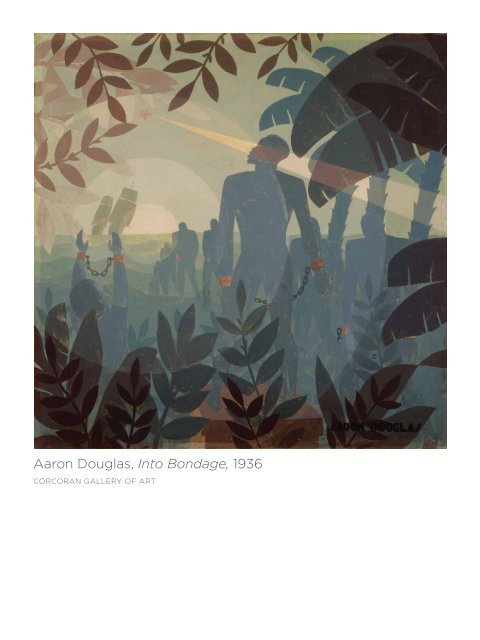
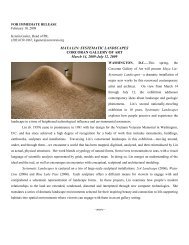
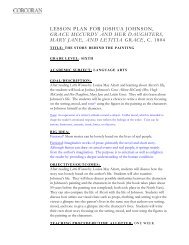
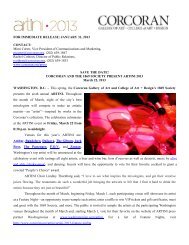


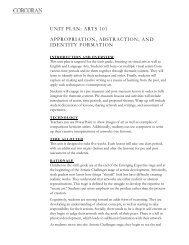
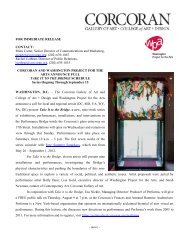

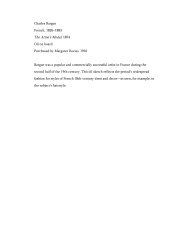
![[PDF] Ellen Harvey: The Alien's Guide to the Ruins of Washington, DC](https://img.yumpu.com/32942537/1/190x190/pdf-ellen-harvey-the-aliens-guide-to-the-ruins-of-washington-dc.jpg?quality=85)
